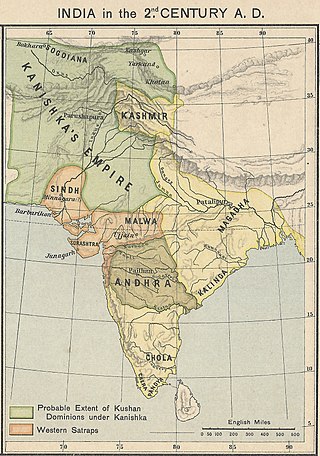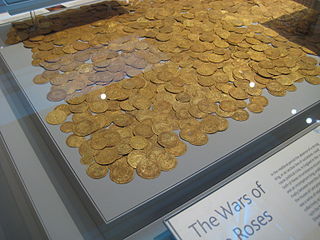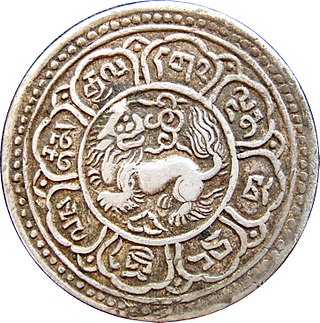
A coin is a small object, usually round and flat, used primarily as a medium of exchange or legal tender. They are standardized in weight, and produced in large quantities at a mint in order to facilitate trade. They are most often issued by a government. Coins often have images, numerals, or text on them. The faces of coins or medals are sometimes called the obverse and the reverse, referring to the front and back sides, respectively. The obverse of a coin is commonly called heads, because it often depicts the head of a prominent person, and the reverse is known as tails.

The Kushan Empire was a syncretic empire formed by the Yuezhi in the Bactrian territories in the early 1st century. It spread to encompass much of what is now Uzbekistan, Afghanistan, Pakistan, and Northern India, at least as far as Saketa and Sarnath, near Varanasi, where inscriptions have been found dating to the era of the Kushan emperor Kanishka the Great.

Vāsudeva I was a Kushan emperor, last of the "Great Kushans." Named inscriptions dating from year 64 to 98 of Kanishka's era suggest his reign extended from at least 191 to 232 CE. He ruled in Northern India and Central Asia, where he minted coins in the city of Balkh (Bactria). He probably had to deal with the rise of the Sasanians and the first incursions of the Kushano-Sasanians in the northwest of his territory.
There are various kinds of Xinjiang coins produced throughout the history of Xinjiang using the styles of contemporary Chinese cash coins as well as Persian and Islamic coinages. As not many records exist from the ancient monarchies of Xinjiang the study of its coinage has determined when which rules reigned and the state of the economy based on metallurgical analyses.
The Kidarites, or Kidara Huns, were a dynasty that ruled Bactria and adjoining parts of Central Asia and South Asia in the 4th and 5th centuries. The Kidarites belonged to a complex of peoples known collectively in India as the Huna, and in Europe as the Chionites, and may even be considered as identical to the Chionites. The 5th century Byzantine historian Priscus called them Kidarite Huns, or "Huns who are Kidarites". The Huna/Xionite tribes are often linked, albeit controversially, to the Huns who invaded Eastern Europe during a similar period. They are entirely different from the Hephthalites, who replaced them about a century later.

The British Museum Department of Coins and Medals is a department of the British Museum involving the collection, research and exhibition of numismatics, and comprising the largest library of numismatic artefacts in the United Kingdom, including almost one million coins, medals, tokens and other related objects. The collection spans the history of coinage from its origins in the 7th century BC to the present day, and is representative of both Eastern and Western numismatic traditions.

The use of historical money in Tibet started in ancient times, when Tibet had no coined currency of its own. Bartering was common, gold was a medium of exchange, and shell money and stone beads were used for very small purchases. A few coins from other countries were also occasionally in use.

Punch-marked coins, also known as Aahat coins, are a type of early coinage of India, dating to between about the 6th and 2nd centuries BC. It was of irregular shape. These coins are found over most parts of subcontinent and remained in circulation till the early centuries CE.
Gilbert Kenneth Jenkins was a leading figure in 20th-century numismatics. He was the post-war generation's most important expert in the study of Greek coins and medals and would become Keeper of Coins and Medals at the British Museum in 1965.

Kipunada, also Kipanadha, was probably the last ruler of the Kushan Empire around 335-350 CE. He is known for his gold coinage. He succeeded Shaka I. Kipunada was probably only a local ruler in the area of Taxila, in western Punjab, and he may have been a subject of Gupta Emperor Samudragupta.

Barclay Vincent Head was a British numismatist and keeper of the Department of Coins and Medals at the British Museum.
John Allan, was a British numismatist and scholar of Sanskrit. Allan was a noted numismatist and produced the first systematic study of the coins the Gupta Empire, which remains a standard reference today.
Silk Road Numismatics is a special field within Silk Road studies and within numismatics. It is particularly important because it covers a part of the world where history is not always clear – either because the historical record is incomplete or is contested. For example, numismatics has played a central role in determining the chronology of the Kushan kings.
Helen Kay Wang is an English sinologist and translator. She works as curator of East Asian Money at the British Museum in London. She has also published a number of literary translations from Chinese, including an award-winning translation of a Chinese children's book.
The Lhotka Memorial Prize is a prize awarded to the author of a publication about numismatics which is considered most helpful to the elementary student of numismatics published in the previous two calendar years.
Nicholas Manning Lowick (1940-1986) was a leading specialist in Islamic numismatics and epigraphy at the British Museum.
The British Museum Catalogues of Coins was a series envisioned and initiated by Reginald Stuart Poole, Keeper of the Department of Coins and Medals, at the British Museum, between 1870 and 1893. The aim was to produce a scholarly series of catalogues of the collection, based on the British Museum's collection and other collections. The series continued after his retirement, and continues to this day, with the collection increasingly being made available online.
Steve Cribb was an English disability rights activist, artist, collector and numismatist.

Peroz II Kushanshah was the penultimate Kushanshah of the Kushano-Sasanian Kingdom from 303 to 330. He was the successor of Hormizd II Kushanshah.
Eduard Kann (1880–1962) was an Austrian banker and a specialist in Chinese numismatics. His book The Currencies of China (1926) was "immediately the standard work on the subject of metallic currencies in China"









